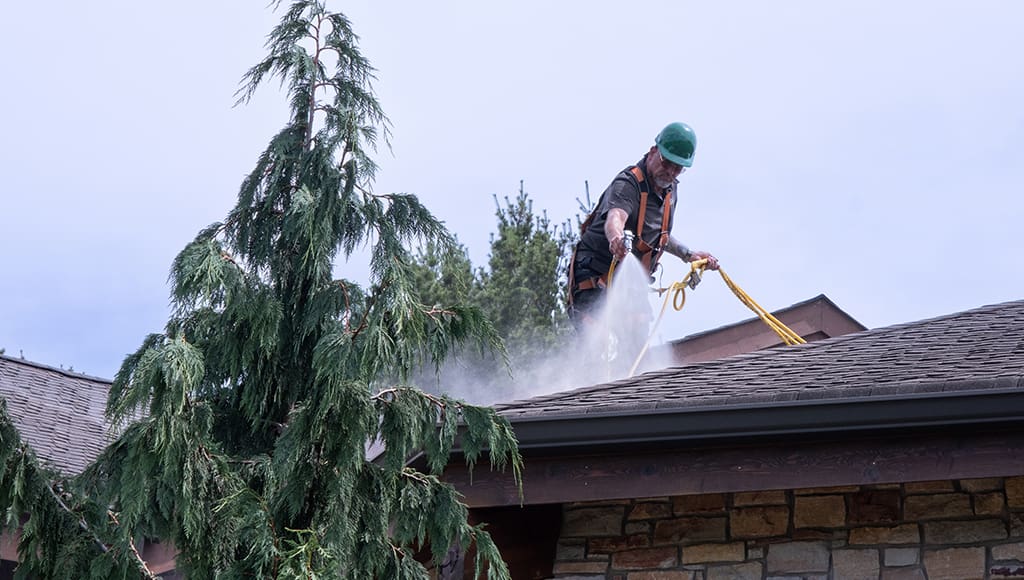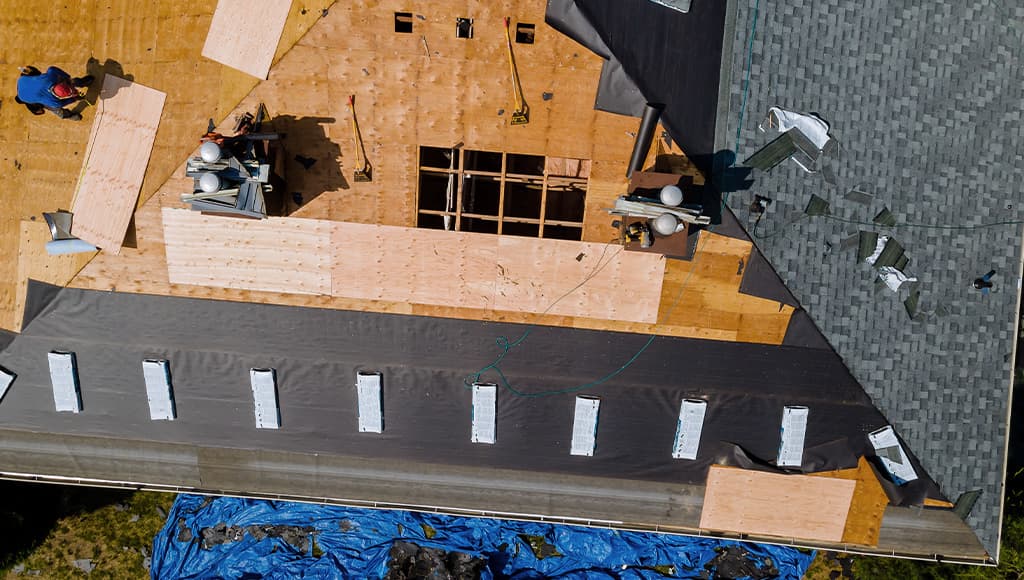Whether you should replace or restore your roof depends on the condition it’s in, your budget, and if your home insurance covers this type of renovation. Regular roof maintenance, including cleaning gutters, removing debris, trimming tree branches, and Roof Maxx may help prolong the life of your roof or buy you more time before you need a full replacement. Costs to install a new roof range from $10,000–$50,000+ depending on the material you choose, the complexity of the structure and your location.
| Time to Read | About 7–9 minutes |
| What You’ll Learn |
|
| Next Steps |
|
A strong roof overhead is one of every homeowner’s most basic needs because it’s what keeps all of the people and belongings under it safe and secure. So, when it begins to show signs of wear and tear, it’s easy to feel discouraged and confused about what to do next.
You have two main options: restore it or replace it. With roof replacement, you’re looking at a professional coming out to tear off the existing materials and replace them and the costs can be high. Restoration solutions like Roof Maxx are more affordable because they focus on helping extend the lifespan instead.
Below, we’ll break down the pros and cons of each option and tell you how to get more life out of your existing roof. We’ll also estimate what you can expect to spend on either option.

Not every aging roof needs to be torn off and replaced. Too many homeowners can get wrapped up in the idea that it’s the only option and end up spending more than they have to in the long run.
This is especially true if you have an asphalt shingle roof because:
Restoration solutions tend to work best if the treatment is applied by around year 10 and/or before any serious deterioration sets in. But we’ve seen cases where it’s worked on roofs well over 20 years old, so don’t write it off just because of age alone.
The takeaway? A well-timed restoration can help delay a costly replacement considerably. If you already have severe damage, like holes or leaks, replacement might still be unavoidable.
Read more: How to Estimate the Age of Your Roof

Regular upkeep is the best way to slow down roof deterioration and avoid unexpected costs. Even with good maintenance, every roof eventually reaches the end of its lifespan, but small preventive steps can add years before replacement becomes necessary.
You can also:
Tree limbs are some of the worst offenders on this list because they hold moisture against the surface of your roof, which can accelerate deterioration. Water damage is a surefire way to reduce a roof’s lifespan.
Roof Maxx’s soy-based restoration treatment can save you thousands of dollars and prolong the life of your shingles by at least five years, guaranteed. It’s convenient, affordable, and won’t interrupt your life for days or weeks, but let’s take a closer look at what most homeowners can expect in terms of costs.
The price of fixing a roof depends on where you live and how much of the roof needs to be replaced. Fixing a few shingles here and there may only cost a few hundred dollars, but total roof replacement is much more expensive.
On the average 2,000-sq-ft home, you can expect to pay:
Expenses break down to about 40% materials and 60% labor.
It’s also really important to point out that you should always make sure the company provides at least a 5–10 year warranty if you decide to replace your roof. This ensures you have options if it fails early.
Did you know? You can also get a free estimate for roof replacement based on your specific roofing conditions and other factors by using Roof Maxx’s Roof Replacement Cost Calculator.
Asphalt shingles are the most affordable to replace, while metal, steel, and slate roofs are significantly more costly. Copper is the most expensive, but it’s undeniably beautiful, while most other metals will last over 50 years as long as they’re properly installed and you have the structure to support them.
If you’re considering steel, copper, slate, or other alternatives to asphalt shingles, you should calculate the greater installation costs and compare it to the cost to maintain them. It’s usually considerably higher than the typical price of putting on new shingles, which is exactly why so many people default to asphalt!
Maybe, as long as your policy includes roof maintenance coverage or roof replacement coverage. You’ll need to take a look at your policy or contact your broker/agent to find out for sure, but they’ll typically only cover you in the case of total loss from events outside your control, like severe hail or storms.
That’s why regularly monitoring the condition of your roof and performing maintenance is so important. Insurance won’t cover roof damage caused by wear and tear or ignored repairs. Don’t give them another reason to refuse you coverage by skipping yearly inspections!
Sometimes, a roof is just at the end of its lifespan and needs to be replaced. This is commonly the case on houses where the structural damage to the roof itself or the underlayment/underpinnings is so severe that repairs would be impractical or impossible.
This may be the case for you if you have:
Don’t wait until it’s deteriorated or damaged to the point that you have no choice but to start planning. It’s better to do what you can now to keep it in good condition, and have a plan in place beforehand.
Spring or fall is usually the ideal time to replace a roof, since winter can be cold and snowy and summer can be very hot. But roof replacement can really be done at any time of year. What’s most important is that you’re prepared to pay for it.
Keep in mind, the roofing company will need to do repairs on a day that’s free of rain or snow in order to safely make repairs and replacements. You might get a lower rate from the installer if you get it done in the offseason.

If you must replace your existing roof, it’s always best to remove the old roofing materials first. This creates a clean, fresh surface that makes it easier to install new shingles properly. But it can also be expensive.
Can’t you just skip this step? No, not really. Here are some other reasons why removal of the old roof is vital before replacement.
If your rooftop is a strong candidate for residential roof restoration via Roof Maxx, you’ll spend much less. Roof Maxx typically costs up to 80% less than totally replacing your roof. This can leave you with more money in your home improvement budget (or to spend on other priorities).
Restoration is also much more environmentally friendly than full roof replacement. Replacing shingles creates millions of tons of waste each year in the United States alone. Roof restoration solutions like Roof Maxx keep your shingles going strong, which means they won’t end up in the landfill like they would with a full replacement. Restoration is more sustainable by a mile!
Roof replacement is expensive and unnecessary in many situations. Before you commit thousands of dollars and days or weeks of your time on having a brand-new asphalt shingle roof put in, take the time to find out if you can benefit more from Roof Maxx’s affordable, eco-friendly roof rejuvenation solution. Get a free custom estimate or get connected to the dealer closest to you now to learn more.
With our five-year, transferable warranty, you’ll enjoy the peace of mind that your roof and entire home are protected.